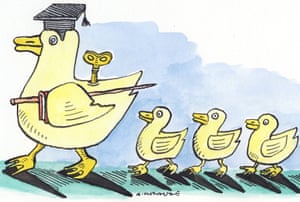Hay peores cosas que no aprender a leer en preescolar
Escrito por Gaye Groover Christmus. Traducido por Trinus
El año que Sam comenzó preescolar, cumplió 6 el mes de octubre. Él era uno de los niños más grandes de su salón de clases y aún no sabía leer. Cuando comenzó primer grado, tenía casi 7 y aún no sabía leer. Afortunadamente para Sam, él entró a primer grado en 1999. Sus maestras, Miss Grant y Miss Floyd no se preocupaban si sus alumnos sabían leer en preescolar. Es más, esperaban que la mayoría de niños comenzaran a leer en primer grado. (Claro, motivando a quienes aprendían a leer fácilmente en preescolar).
Si Sam hubiera comenzado primer grado este año, probablemente lo hubieran etiquetado de estarse quedando atrás. El nuevo estándar es que los niños deben aprender a leer en preescolar. A pesar que la mayoría de educadores están conscientes que esto no debería de suceder hasta primer grado. Sam se convirtió en un buen lector a finales de primer grado. En el momento que llego a la secundaria, era un estudiante de cuadro de honor y se graduó de la universidad con un GPA de 3.93/4.
¿Entonces, qué pasa cuando los estándares de la educación requieren que niños como Sam aprendan a leer en preescolar y que las maestras hubieran forzado que esto sucediera? Muchos educadores dicen que esto resulta en tiempo de clase ineficiente y contraproducente. Esto quiere decir que muchos niños realmente aprenden y retienen menos información de lo que harían en una clase adecuada para su edad.
Entonces, les doy mi consejo (lo pueden tomar si quieren, porque no soy una maestra, pero si soy la madre de Sam). Si tu hijo no aprende a leer en preescolar, no te estreses. Porque hay muchísimas cosas peor que no aprender a leer. A continuación, te mencionaré 4 de ellas:
• Tiempo limitado para juego creativo. Los niños pequeños aprenden por medio del juego. Aprenden al moverse, al construir, al botar cosas, pero no llenando varias hojas de trabajo. También aprenden al interactuar con otros niños, al solucionar problemas, al compartir y cooperar, no aprendiendo fonética a los 6 años. Mrs. Grat y Mrs. Floyd creaban centros maravillosos y rincones que permitían a los alumnos a aprender cualquier cosa desde casas a camiones, de perros a océanos… También incluían actividades que requerían habilidades de lectura y matemáticas, y lo mejor de todo es que los alumnos no se dan cuenta que están trabajando porque están muy concentrados creando y jugando. Los maestros hoy en día, tienden a limitar o incluso eliminar juego porque los requerimientos académicos son tan fuertes que se han visto forzado a eliminar este tiempo donde aprenden de una manera creativa.
• Tiempo limitado para actividad física. Pocas cosas son tan contraproducentes como limitar el tiempo de recreo y otros tipos de juego físico para los niños. Los niños aprenden mejor cuando se mueven. Ambos papas y maestros saben esto de pura intuición, y hay muchos estudios que lo confirman. Los niños que tienen más oportunidades de correr por allí y jugar, tienden a tener mejores destrezas de pensamiento y su actividad cerebral es mayor. Y no asumas que los niños son naturalmente activos y que hacen la cantidad de ejercicio que necesitan a diario, estudios han encontrado que los niños de tres y cuatro años son sorprendentemente inactivos. Y, aun así, varios colegios están limitando y eliminando el tiempo de recreo, hasta para los más pequeños.
• Aprendizaje enfocado en estándares y exámenes. Las maestras están constantemente bajo presión para preparar a sus alumnos para poder salir bien en estas pruebas estandarizadas. Esto quiere decir que el enfoque principal de los maestros, ya no es enseñarles a los niños de la mejor manera para ellos, pero les están enseñado para que sean exitosos en las pruebas. Una maestra dijo, “he notado como los requisitos de mi trabajo se han alejado del enfoque del niño, de su forma de aprendizaje, de sus necesidades emocionales, y sus familias; ahora todo el interés está centralizado en exámenes, pruebas y calificar a los alumnos…” Este cambio resulta en que los maestros tengan menos tiempo para inculcar en sus alumnos las disciplinas para que sean aprendices de por vida.
• Frustración y sentido de fracaso. Los niños saben que no están cumpliendo con las expectativas de sus maestros y de otros adultos. Lo que no saben, es que todas estas expectativas no hacen ningún sentido, y por no saber esto, ellos sienten frustración y sentido de fracaso cuando no dan la “talla”. Para dar un ejemplo, el niño que le fue muy bien en su preescolar experimental pero luego tiene problema en su colegio enfocado en lo académico, se podrá sentir frustrado a tal punto de sentir que “odia el colegio”. Y la niña que no se puede quedar quieta por más de 30 minutos y llenar todas las hojas de trabajo, sabe que está decepcionando a su maestra, pero lo que ella no sabe es que esa tarea no es adecuada para niños de su edad. Lo cual quiere decir que muchos niños normales se frustran cada vez más y están siendo etiquetados por un sistema completamente irreal. Un artículo dice: la mayoría de niños ansían sobrepasar todas las expectativas que tienen, pero las herramientas y destrezas como aprendiz así como su entusiasmo para aprender sufren cuando las demandas son inapropiadas para su edad.
Si tu hijo está en preescolar o primer grado y aún no sabe leer, no te preocupes. Habla con su doctor si tienes alguna preocupación, pero reconoce que él/ella se está desarrollando como debe de ser. Si el colegio de tu hijo(a), empuja mucho en el área académica en vez de incentivar el juego, habla con la maestra. Te aseguro que él/ella está bajo muchísima presión para que sus alumnos salgan bien en sus exámenes. Si estas estancado con un currículo de preescolar que se ve irreal y no encaja con tu hijo(a), hazle saber a tu hijo(a) que tú no estás preocupado porque aprenda a leer. Habla de gente que no ha comenzado a leer hasta después (como Sam), y están bien. Luego, haz cosas que promuevan aprender de distintas maneras, como leerle un cuento que disfrute, jugar juegos, enseñarle destrezas útiles, y sácalos a divertirse a la naturaleza lo más que puedan, sean activos y aprendan juntos.
Te compartimos el link al artículo original.





























